Beijing Travel Guide
China's huge capital city is a perennial favourite with tourists and backpackers, who relish its wide range of unusual sights, sounds, smells and tastes. The city's unique cultural elements are alive and well and can be experienced first-hand through indigenous cuisine, temples and traditional performances. Beijing is nevertheless more than up-to-date with modern trends and fashions, partly as a result of its cosmopolitan expat population and partly because China is increasingly an international trend-setter in its own right.
A global hub of business, culture and entertainment, Beijing has an incredibly diverse nightlife that will keep even the most demanding of socialites satisfied at all hours, especially during the summer months, when areas such as the Sanlitun bar street are buzzing from dusk till dawn. Visitors hoping to lighten their pockets will also have no shortage of shopping opportunities; from bustling markets such as Silk Street (Xiushuijie) to colossal shopping malls like the 13-storey Xidan Joy Center, Beijing has it all.
China is a teeming medley of more than 50 officially recognised ethnic minorities and Beijing, as the country's capital, is suitably varied and representative. The city's many attractions are testament to this, and visitors will find exploring everything fully a near-impossible task.
Best time to visit Beijing
Beijing's climate is one of extremes. With hot, humid summers and chilling, dry winters, travellers will find that spring and autumn (April to May and September to October) are the best times of year to visit. The weather during these seasons is pleasant, temperate and highly conducive to sightseeing.
What to see in Beijing
-The breath-taking and historically poignant Tiananmen Square is a must-see for those visiting Beijing.
-It is practically an obligation for travellers to journey out of the city to see the Great Wall; tourists can stroll along the historic landmark at a number of different locations.
-The Beijing National Stadium, also known as the Bird's Nest during the 2008 Olympics, is a spectacular feat of modern architecture.
-Experience the thriving Beijing art scene in 798 Space, a notable gallery in the city's famous art district.
What to do in Beijing
-Hire a pedal boat and relax on the majestic waters of Beihai Park.
-Experience the beauty of Chinese culture in the Summer Palace.
-Take a tour of the cryptic reminder of cold-war fears that is The Underground City.
-Learn about the diversity of aquatic life at the Beijing Aquarium.
-Travellers can learn about early humans and see the remains of the famous 'Peking Man' at the Zhoukoudian Cave, just south of the city.
Beyond Beijing
Despite its size, travelling within China is relatively simple. This is especially the case from its capital city, as there are frequent buses, trains and flights going to all corners of the country. From Beijing, travellers may enjoy meandering down to Xi'an, resting place of the remarkable Terracotta Army, or to Chengdu, home of the world's largest Panda Breeding and Research Center.
Getting there
All international flights to the city will land in Beijing City International Airport, located 17 miles (28km) north of the city. From the airport, visitors can either take a taxi, shuttle service or express train to the heart of the city and beyond. Beijing's extensive public transport system, while generally crowded, is reliable; visitors should not experience much difficulty navigating.
Did you know?
-Despite being called the 'kingdom of bicycles', the number of cyclists in Beijing has more than halved in the past 15 years; this is largely a result of the city's growing middle-class, who consider owning a car to be a greater status symbol.
-Beijing's signature dish, Peking Duck, is a carefully prepared delicacy that has been around since the imperial era and is a favourite of Henry Kissinger.
-Beijing's subway is one of the busiest in the world, with more than 11 million trips on a busy day.
Things to do in Beijing
Though Beijing still offers well-preserved glimpses into millennia of Chinese history, it is far more than a large-scale museum. Instead, eye-catching structures and modern architectural wonders are among the city's most visited attractions. These include the National Stadium, better known as the Bird's Nest, and the National Grand Theatre, known as the Eggshell. It is no surprise that some traditionalists believe the modern attractions detract from the city's ancient treasures, but many more enjoy the stark contrast.
However, the iconic historic Beijing sites remain the most popular. The Great Wall of China and the mysterious Forbidden City at the heart of Beijing compete for the title of the city's most visited attraction. Beihai Park and the Summer Palace are also immensely popular. For truly ancient history, travellers should visit the Zhoukoudian Cave, which boasts the largest collection of Homo Erectus fossils in the world. More recent history can be explored at the infamous Tiananmen Square or the Chairman Mao Mausoleum.
Being able to walk through some of the world's most ancient and modern attractions in a single day makes Beijing eternally captivating.
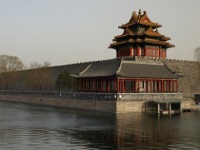
Forbidden City
The majestic Forbidden City is a historical precinct situated in the heart of Beijing. This UNESCO World Heritage Site has been declared the largest collection of preserved ancient wooden structures in the world. The Forbidden City, called Gu Gong in Chinese, was the imperial palace during the Ming and Qing dynasties.
It is the biggest and best preserved complex of ancient buildings in China, and the largest palace complex in the world. Construction began in 1407, and for 500 years this inner sanctum was off limits to most of the world as the emperors lived in luxury, secluded from the masses and surrounded by their families, servants and members of court.
The Forbidden City has a permanent restoration squad working continuously to keep the more than 90 palaces and courtyards, 980 buildings and 8,728 rooms in perfect condition. Now open to all visitors, its museum is home to a priceless collection of ancient artefacts. The complex can get overrun so it is best to go early in the morning to fully appreciate the layout of the place without too many crowds.
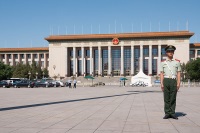
Tiananmen Square
The famous and distinct Tiananmen Square is at the heart of Beijing, a place of so many historic events. The largest city square in the world, it was a gathering place and site of government officials during ancient imperial days. Major rallies took place in the Square during the Cultural Revolution, when Chairman Mao reviewed military parades up to a million strong. But the 1989 Tiananmen Square Massacre meant it has become a site of great political significance in modern history.
The square is surrounded by several monuments, some ancient and some modern, including the former gates to the Forbidden City, the Gate of Heavenly Peace and Qianmen, as well as the Chinese Revolution Museum and the Mao Mausoleum, where China's former leader lies preserved. There is also an underground walkway connecting Tiananmen Square with the Forbidden City. Like most big tourist attractions in China, it is best to try and go early in the day to avoid the masses, with the square open to visitors as early as 5am.
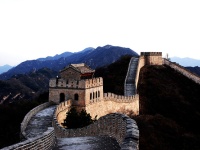
Great Wall of China
The Great Wall of China is a perennial favourite among tourists. Stretching some 4,000 miles (6,350km) and built in stages from the 7th century BC onwards, it snakes across the mountains and valleys of five provinces in northern China and originally served as a mammoth defensive bulwark against neighbouring Manchurian and Mongolian peoples.
Several sections of the wall, which has become the most prominent symbol of Chinese civilisation, can be viewed in the greater Beijing area. In Yanqing county, in northwest Beijing, is the 600-year-old Badaling Fortification, representative of the Ming dynasty sections of the Great Wall. Other sections can be seen at Jinshanling, Mutianyu and Simatai.
The more popular sections can be very crowded but, generally, if travellers walk a little way they can escape the worst of it. There are some wonderful stretches of the wall to hike, such as the roughly six-mile (10km) section between Jinshanling and Simatai, but visitors should be careful about setting off alone as parts of the wall are unstable and unsafe.
It's recommended that tourists take their own water and snacks and pack warm clothes if planning to go during winter, as temperatures at the wall can be freezing. There are countless vendors, but their goods are usually overpriced and of questionable quality. It is illegal to remove stone from the wall and Chinese authorities are clamping down on the practice.
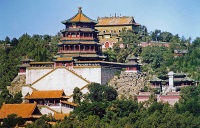
Summer Palace
The magnificent Summer Palace was built in 1750 by the Emperor Qianlong, and continued to be an imperial residence until the Empress Dowager Cixi died in 1908. It is the largest and most well-preserved royal park in China, and has been declared a UNESCO World Heritage Site.
The palace and stunning gardens are open to visitors, who pass through a grand courtyard into the Hall of Benevolent Longevity, the Hall of Jade Ripples and the Hall of Joyful Longevity. Empress Cixi's private theatre in the Garden of Moral Harmony is a must see, as is the long corridor that skirts Kunming Lake's northern shoreline to reach the marble boat, an elaborate two-storey structure of finely carved stone and stained glass.
All in all, the Summer Palace boasts not only famously beautiful grounds but also 3,000 man-made ancient structures, including mansions, temples, pavilions, bridges and towers. Once a place for weary royals to relax, the Summer Palace is now a sanctuary for travellers and, although it can get crowded, it always seems calmer and cooler than the rest of the city.
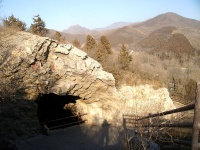
Zhoukoudian Cave
About 25 miles (40km) south of Beijing, in the Fangshan District, is the Zhoukoudian Cave, the source of the largest collection of Homo erectus fossils from any single site in the world. The fossils recovered from the cave represent about 40 individuals, most famous of which is a cranium element commonly known as the 'Peking Man', the world's earliest fire-using primitive man who lived between 200,000 and 700,000 years ago.
The Zhoukoudian site on Dragon Bone Hill has a comprehensive seven-room exhibition of fossils and artefacts depicting human evolution and the lifestyle of primitive humans. It showcases fossils from all over China, allowing visitors to compare the different lifestyles of the ancient communities that were discovered here.
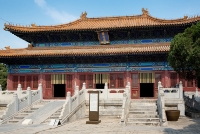
Tombs of the Ming Dynasty
Built by the emperors of the Ming Dynasty of China, the majority of surviving Ming tombs are clustered near Beijing and easily reached on short excursions out of the capital. Thirteen emperors' mausoleums, dating from between 1368 and 1644 and collectively UNESCO-listed, can be seen in the Ming Tombs Scenic Area at the foot of Tianshou Mountain.
Currently only three of the tombs are open to the public (Chanling, Dingling and Zhaoling) but this is more than sufficient as all the tombs are similar in design and the three that can be explored are arguably the most interesting. The Changling Tomb is the largest, oldest and best preserved, looming majestically at the end of the Sacred Way. The Dingling Tomb is the only one which has been properly excavated but tragically many of the artefacts and the remains of the emperor and empresses entombed in the mausoleum were destroyed during the Cultural Revolution. Even so, the excavated Underground Palace in Dingling is fascinating and some magnificent artefacts can still be viewed.
Many operators in Beijing offer tours to the Ming Tombs, often combined with trips to the Great Wall and other nearby attractions. Visitors travelling independently will need to pay entry to each tomb separately.
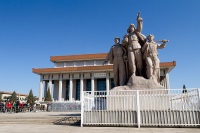
Chairman Mao Mausoleum
Although Chairman Mao Zedong requested to be cremated, his body was instead embalmed. After a supposed mishap during the process, a wax model was made as backup and it's unknown which version of the Great Helmsman is on display today at the Mausoleum. The Mausoleum itself was built in 1977 on the prior site of the Gate of China, the main gate of the Imperial City during the Ming and Qing dynasties. The tomb is on the first floor and on the second is a museum dedicated to other great communist leaders, including Mao himself. Those interested in visiting the Mausoleum can join the long line of visitors outside the building every day. Visitors should remember to dress respectfully and maintain silence in the mausoleum, as the site is a place of worship more than a tourist destination.
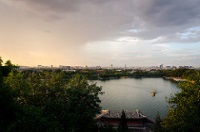
Beihai Park
A place of tranquillity and grand imperial beauty, the Beihai Park is one of the great attractions of Beijing. It's centrally located and close to the Forbidden City and Jingshan Park, providing a peaceful, natural haven after a long morning of sightseeing. One of the oldest and best preserved imperial gardens in China, Beihai Park's history extends over 1,000 years to the ancient Liao dynasty, which ruled between 916 and 1125. Built up through five dynasties, the park is an emblem of old-world China, designed according to the ancient Chinese art of landscaped gardens with artificial hills, colourful pavilions and intricate temples.
Kublai Khan lived in what is now the Circular City of Beihai Park. The Tibetan-style White Dagoba, built in 1651 on Jade Island, is a landmark for both Beihai Park and Beijing, having been constructed on the suggestion of a famous Tibetan Lama priest, NaomuHan. Apart from the famous White Dagoba and the Circular City, landmarks within Beihai Park include Hao Pu Creek Garden, the Quiet Heart Studio, Nine-Dragon Screen and the Five-Dragon Pavilions. The Fangshan Restaurant, started nearly a century ago by royal chefs, is also worth a visit.
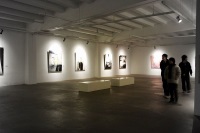
798 Space
Beijing's prominent art district is home to 798 Space, an art gallery housed in a former electronics factory that built components for China's first atomic bomb and early satellites. Exhibiting the latest in contemporary Chinese art in its lofty viewing rooms, 798 Space is a visual delight for any traveller. Besides regular national and international exhibitions, 798 Space also hosts corporate and commercial events such as fashion shows, product launches, conferences and fairs. A film and video viewing area and a gallery bookshop are also housed in the gallery, as is a colourful little restaurant. The art precinct itself is dotted with avant-garde statues, charming coffee shops and noodle bars, and a plethora of other wonderful art galleries to visit.
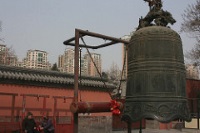
Great Bell Temple
The Qing Temple is home to the Ancient Bell Museum (Gu Zhong Bowuguan) and is a great stop for travellers en route to the Summer Palace. A 47-ton bell with a height of 22.7 feet (6.9m) was transported to the original temple on ice sleds in 1743. It is inscribed with Buddhist Mantras on both the inside and outside and features over 227,000 characters.
The bell was often chosen by the emperors to pray for rain and blessings for the people of China, and was one of three projects that the Yongle Emperor of the Ming dynasty (1368-1644) commanded after reestablishing Beijing as the capital, the others being the Forbidden City and the Temple of Heaven. The bell is considered auspicious in Chinese tradition and is nowadays rung 108 times to begin the celebrations at grand ceremonies. There are a further 31 bells on display in the Ancient Bell Museum, most with tributes to various emperors inscribed on them.
The Underground City
Beijing's Underground City is a forgotten vast bomb shelter eight to 18 meters beneath the ancient capital's downtown area, built in case of nuclear attack. Aside from some rather odd recent additions, it features factories, restaurants, hospitals, schools, theatres and shops. There's even a mushroom farm to provide food easily cultivated in darkness. On Mao Zedong's orders, it was built from 1969 to 1979 by more than 300,000 local citizens including school children, mostly by hand. The tunnels were initially intended to accommodate all of Beijing's six million inhabitants upon completion. Winding for over 18 miles (30km) and covering an area of nearly 53 square miles (85 sq km), the underground City includes more than 1,000 anti-air raid structures.
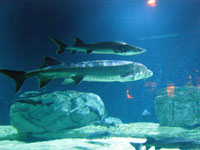
Beijing Aquarium
Located within the Beijing Zoo, the Beijing Aquarium is one of the world's largest inland aquariums. Its interactive exhibits provide an immersive experience that never fails to delight, such as an imaginative Amazon rainforest, complete with piranhas and pandas, as well as an exquisite shark tank, dolphin shows and displays of rare and endangered fish. A boat from the canal south of the aquarium runs to the Summer Palace, giving visitors the opportunity to sightsee while en route to the attraction.
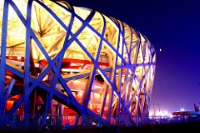
The Beijing National Stadium
The Beijing National Stadium, also known as the Bird's Nest due to its appearance, was the hub of the 2008 Summer Olympic Games, hosting all of the track and field events as well the opening and closing ceremonies. The unique-looking supports make it the largest steel structure in the world, created using a web of steel frames converging in a grid formation. The visual effect is unique and impressive and it was designed to symbolise harmony between technology and nature. The stadium has reopened as a tourist attraction, and the public can tour the facilities, or visit the ski resort now housed inside during the Happy Snow season.
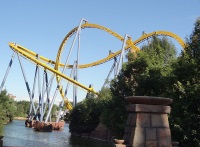
Happy Valley Amusement Park (Beijing Huanle Gu)
Happy Valley is a fantastic place to spend the day with or without the little ones. It features about 40 rides, an IMAX Theatre and even a shopping centre. It is similar in style and layout to Disneyland, featuring six theme parks: Fjord Forest, Atlantis, Happy Hour, the Aegean Sea, Lost Maya and Shangri-La. Atlantis is probably the favourite of these, with a massive palace built in its centre. But Happy Valley gets equally crowded on the weekends, with queues lasting up to three hours for rides. To avoid disappointment, visitors are advised to find out ahead of time whether the state-of-the-art roller coasters will be running as some rides close during quiet periods.
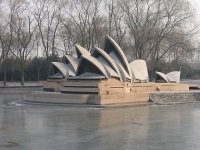
Beijing World Park
The Beijing World Park is must see on the itinerary of those travelling with children in Beijing. It features about 100 miniature models of some of the world's most famous tourist attractions from over 50 countries across the globe, and is designed to let visitors experience a trip around the world without ever having to leave Beijing. The sights include Egypt's Great Pyramids, France's Eiffel Tower, India's Taj Mahal, England's Stonehenge and New York City's Manhattan Island. The park is a great place for kids to learn and enjoy naming the attractions as they stroll through the replicas. Summer is the best time to visit Beijing World Park, as it's a venue designed for sunny weather.
Things to do with kids in Beijing
Steeped in a mystical and fascinating ancient history, Beijing may not, at first glance, seem ideal for travel with children. However, those who look past the old buildings and temples will find more than enough fun activities and attractions to enjoy with kids.
The Summer Palace is a good place to start sightseeing. With magnificent gardens open to visitors, children will have plenty of space to run around. The Happy Valley Amusement Park never fails to entertain and thrill the whole family, as moms can wander around the shopping centre while the kids are at play. Milu Park ranks as one of the best places to enjoy a picnic outdoors and do some milu deer spotting, while spectacular sealife waits at Beijing Aquarium. Another highly entertaining park is Chaoyang, which is the biggest in Beijing.
On rainy or particularly hot and humid days, visitors can take the kids to Le Cool, an indoor ice skating rink, or to one of the many indoor playgrounds around the city, such as Fundazzle. It's a great way to ensure happiness and tiredness.

Happy Valley Amusement Park (Beijing Huanle Gu)
Happy Valley is a fantastic place to spend the day with or without the little ones. It features about 40 rides, an IMAX Theatre and even a shopping centre. It is similar in style and layout to Disneyland, featuring six theme parks: Fjord Forest, Atlantis, Happy Hour, the Aegean Sea, Lost Maya and Shangri-La. Atlantis is probably the favourite of these, with a massive palace built in its centre. But Happy Valley gets equally crowded on the weekends, with queues lasting up to three hours for rides. To avoid disappointment, visitors are advised to find out ahead of time whether the state-of-the-art roller coasters will be running as some rides close during quiet periods.

Beijing World Park
The Beijing World Park is must see on the itinerary of those travelling with children in Beijing. It features about 100 miniature models of some of the world's most famous tourist attractions from over 50 countries across the globe, and is designed to let visitors experience a trip around the world without ever having to leave Beijing. The sights include Egypt's Great Pyramids, France's Eiffel Tower, India's Taj Mahal, England's Stonehenge and New York City's Manhattan Island. The park is a great place for kids to learn and enjoy naming the attractions as they stroll through the replicas. Summer is the best time to visit Beijing World Park, as it's a venue designed for sunny weather.
Eating Out
The multitude of local dishes in Beijing has made for some of the longest menus in the world. Whether diners choose traditionally cooked meals or new takes on old favourites, eating out in Beijing will be like nowhere else in the world. From ingredients meant for royalty in Imperial Cuisine to the more 'mysterious' ingredients of a street-side Jianbing (savoury pancake), food preparation in Beijing adheres to old traditions that reflect culinary styles from all over China.
Chinese food in Beijing differs dramatically from the fare in Chinese restaurants worldwide. Beijing's famous Peking roast duck is the star attraction, with several restaurants devoted entirely to the one dish. For a chance to sample many different kinds of local food, travellers should visit one of the 'snack streets', such as Guanganmen Snack Street, or Gui Street, all with dozens of vendors plying their specialties. The more adventurous visitors can peruse the Donghuamen Snack Night Market in Wangfujing, which is famous for Chinese delicacies such as centipedes, grasshoppers, sheep privates and offal soup.
Migrants have infused the city's cuisine with new cultures and tastes, reflected in the blossoming choices in Beijing restaurants. International-style restaurants are popping up all over the city, with top international chefs enjoying great success.
More expensive restaurants in Beijing will generally accept credit cards, but street vendors and takeaway joints will expect cash. While hotel restaurants will sometimes include a 10 to 15 percent service charge, tipping is not generally expected in Beijing.
Shopping
Shopping is a delight in Beijing, and the haggling and bargain-hunting is a cultural experience. Walking and bargaining in the countless markets in Xiu Shui Jie Shopping Mall or the Xiu Shui Market will no doubt build up an appetite but luckily there are plenty of food stalls where shoppers can refuel. Popular buys include fake designer labels, clothing and bags. Bargaining is an essential skill and an expected part of the transaction but visitors should remember to keep smiling.
The main shopping area is around Wangfujing Dajie, where a number of department stores can be found, including the Beijing Department Store. The Xidan area offers wonderful big department stores selling fixed-price goods including electronic equipment. The Hong Qiao Market is a popular indoor market in the south central area of Beijing, where bargaining is expected. Here buyers can haggle for goods such as cheap no-name or fake brand electronics, sunglasses, batteries, watches and jewellery.
Panjiayuan Collectors Market is an outdoor market with a good array of arts and crafts from all over China, including popular Beijing souvenirs such as jade bracelets, cloisonne and lacquerware, silk, calligraphy, porcelain and vintage Cultural Revolution books and posters. The Maliandao Tea Street is the best place to find anything associated with tea, including tables, tea sets and a wide variety of teas; it can be found in the southwestern Xuanwu District, near the Beijing West Railway Station.
Liulichang, in south Beijing, is a great place for Chinese antiques. Buyers should be aware that authentic antiques over 100 years old display a red wax seal. An export licence must be issued before these can be taken out of the country.
Travellers are advised to avoid shopping sprees on evenings and weekends when possible, as the crowds can be overwhelming. Shops in Beijing are generally open daily from 9am to 8pm.
Nightlife
Neon lights are a staple of Beijing nightlife, with a predictable swarm of DJ dance clubs and karaoke bars lighting up most corners of the downtown districts. Those wanting an authentic Beijing experience should probably avoid the hotel venues and their cookie cutter disco offerings. Some unique areas popular with locals include Hou Hai Bar Area, a picturesque lakeside nightlife hub, and Sanlitun Pub Street in the Embassy Area of Chaoyang District, a favourite for westerners keen on cheap drinks and a vibrant atmosphere.
There still isn't too much crossover between western and Chinese clientele, but it can be interesting to soak in some Chinese karaoke and liquor at local haunts. Many venues stay open until the early morning, although most people in Beijing go to sleep before some of them even open!
For the more artistically inclined, there are a host of Chinese art shows to enjoy. These include top-quality Chinese opera, dancing, and theatre most nights of the week. Many visitors enjoy seeing kung-fu demonstrations and acrobatic shows. The Laoshe Tea House and the Tianqiao (Overbridge) Area are great places to explore traditional Chinese performances.
Getting Around
The subway is a great way to get around in Beijing, though it can be very crowded at peak hours. The subway shuts down at midnight and starts again at 5am. Travellers can buy a prepaid card (Smart Card) for travel on subways and buses. The fare is the same for the subway, but reduced for buses. Most buses operate from 5am to 11pm, but buses can be slow.
Driving in Beijing is a complicated and sometimes frightening process, with few English signs and non-stop traffic jams. Taxis are plentiful, but visitors should be sure to have their destination written in Mandarin, as few taxi drivers speak English. The ride-hailing app, Didi Chuxing, is also an option.
Cycling is a good alternative as there are numerous bicycle rentals around the city, and well-defined bike lanes, bike parks and the company of millions of other cyclists, especially at rush hour. It may look intimidating, but can be the best way to get around for the more adventurous traveller. Over 40,000 bicycles are available to be rented at outlets close to subway stations, commercial districts, hotels, and office buildings.
Beijing Climate and Weather
The humid continental climate of Beijing is rather extreme. There are four very distinct seasons, with a wide temperature variation between winter (December to February), which is well below freezing, and summer's hot humidity and 79F (26C) average daily temperatures. Most of the rain falls in the summer (June to August); the sudden downpours make an umbrella a necessary travel accessory. Spring and autumn are relatively short seasons. Spring (March to May) has warm and windy conditions. Autumn (September to November) brings blue skies, pleasantly mild temperatures, and slight humidity. Spring and autumn are the best seasons to travel to Beijing.
China travel info
Electricity
Electrical current is 220 volts, 50Hz. Plug types vary, but the two-pin flat blade and oblique three-pin flat blade plugs are common. Adapters are generally required.
Language
The official language is Mandarin Chinese, but there are hundreds of local dialects.
Money
China's currency is the Renminbi Yuan (CNY), which is divided into 10 jiao or 100 fen. Cashless payments via smartphone applications such as WeChat Pay are increasingly commonplace in main cities, and major credit cards are widely accepted. ATMs are widely available in major cities. It is not possible to exchange Scottish or Northern Irish bank notes; banks are closed on weekends.
Tipping
Tipping is not officially recognised in China, though the practice is has become increasingly common among tour guides, top-end restaurants, tour bus drivers and hotel staff. Travellers wanting to tip should leave a gratuity of about 10 percent. Large hotels and restaurants often include a service charge in their bills, usually of around 10 percent, so travellers should make sure that they aren't doubling up.
Health
A yellow fever vaccination certificate is required from travellers coming into China from infected where there is a risk of transmission. There is a risk of malaria throughout the low-lying areas of the country, and it is recommended that travellers to China seek medical advice about malaria before departure. All eligible travellers should be up to date with their COVID-19 vaccines; vaccinations are recommended against hepatitis A and hepatitis B, typhoid (not necessary if eating and drinking in major restaurants and hotels), Japanese encephalitis (usually only recommended for rural areas), and rabies (only recommended for travellers at risk of animal bites). Tap water shouldn't be drunk unless it has first been boiled, filtered or chemically disinfected. Street food should be treated with caution. High levels of air pollution in major cities and industrialised areas in China may exacerbate bronchial, sinus or asthma conditions. There is generally a high standard of health care in major Chinese cities, but it is not provided free of charge; travellers are advised to have comprehensive travel health insurance.
Safety
China is one of the safety countries to visit in Asia. Serious crime against foreigners is rare but does occur, particularly in isolated or sparsely populated areas. If travelling alone, including following parts of the Great Wall, it is advisable to leave an itinerary and expected time of return with a third party. Travellers should take extra care in street markets and at tourist sites, which attract thieves and pickpockets, and around the popular expat bar areas at night, where lone foreigners have occasionally been targetted. Travellers should be cautious about using pedicabs in Beijing, as tourists have reportedly been mugged by the drivers. Disputes over taxi fares can occur. Passengers should insist on paying the metered fare and should ask for a receipt; this has the taxi number on it.
Seasonal heavy rains and typhoons cause hundreds of deaths in China each year, particularly those areas bordering the Yangtze River in central, southern and western China. Demonstrations have taken place in Lhasa, Tibet, as well as in some Chinese provinces in protest against Chinese rule in Tibet. Even though the situation seems to have stabilised, visitors are advised to stay up to date on the situation before travelling to the region and to avoid all protests. The Chinese government sometimes suspends the issue of permits for travel to Tibet due to unrest.
There is currently little threat from global terrorism. The risk of terror attacks is higher in the Xinjiang Uyghur Autonomous Region and travellers should exercise caution if travelling to or around Xinjiang.
Local customs
Chinese people usually have three names, the first of which is their surname, or family name. As a result, visitors should be prepared for hotels mistakenly reserving rooms under their first names. For clarity, surnames may be underlined. When addressing Chinese people, the surname should come first and official titles should be used. Chinese handshakes last longer than those in western countries, and it is customary to stand close together when in conversation. Politeness in western terms is often foreign to the Chinese, and they rarely bother with pleasantries. It is considered disrespectful to keep prolonged eye contact, avoiding eye contact is considered reverential rather than rude. All foreigners should carry their ID on them at all times, as spot checks are common. Failure to show evidence of ID when requested by an official may result in a fine or detention.
Doing business
The Chinese are strict timekeepers and being late for a meeting is considered rude. When meeting people for the first time it is normal to shake hands and say 'ni hao', which means 'how are you'. Handshakes generally go on for longer in China than in most western countries. Business cards are commonly exchanged at the start of meetings in China; it is customary to have one side printed in Chinese and one in English. When giving or receiving business cards or a gift, it is customary to hold it with both hands. Chinese consider gifts an important show of courtesy. Decision-making may take longer than expected during negotiations. During a meal or reception, a host is likely to offer a toast; foreigners may be expected to offer them one in return.
Women are generally treated with respect and courtesy when doing business in China and it is increasingly common to find Chinese women in senior positions, especially in the big cities. Businesswomen should, however, avoid showing too much skin. Business dress for both men and women tends to be conservative and plain without much ornament or bright colour.
Business hours are 8am to 5pm, Monday to Saturday. A five-day week is more common in larger cities and international companies. Workers usually take their lunch break between 12pm and 2pm and it is not unusual to find offices empty during this time.
Duty free
Travellers to China do not need to pay customs duty on 400 cigarettes or 100 cigars or 500g of tobacco; 1.5 litres of alcohol; perfume for personal use; and personal articles up to the value of CNY2000. Prohibited goods include arms, ammunition, or printed material that conflicts with the public order or moral standards of the country. Also prohibited are radio transmitters and receivers, exposed but undeveloped film and fresh produce. Strict regulations apply to the import and export of antiquities, banned publications, and religious literature. All valuables must be declared on the forms provided.
Communications
The international dialling code for China is +86. Hotels, cafes and restaurants offering free WiFi are widely available. As international roaming costs can be high, purchasing a local prepaid SIM card can be a cheaper option.
Passport & Visa
There are a few complex exceptions to Chinese visa requirements, which will not apply to the majority of visitors, but all requirements should be confirmed with a Chinese embassy before travel. All documents necessary for further travel and sufficient funds to cover intended period of stay are required; travel to Tibet will require a special Tibet Entry Permit. It's recommended that passports be valid for six months after intended period of travel.
Entry requirements
US nationals require a passport that is valid for six months after the date of departure. A visa is required for entry into China.
UK nationals require a passport that is valid on arrival for six months after the date of departure. A visa is required for entry.
Canadians require a passport that is valid for six months at the time of entry. A visa is also required.
Australians require a passport valid on arrival, and a visa for entry to China. A valid visa is required.
South African nationals require a passport valid on arrival, and a visa for entry to China.
Irish nationals require a passport valid on arrival, and a visa for entry to China.
New Zealand nationals require a passport valid on arrival, and a visa for entry to China.
Useful contacts
Ministry of Culture and Tourism, Guangxi: +86 773 288 5326, www.topchinatravel.com/
110 (Police); 120 (Ambulance)


